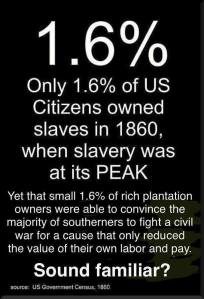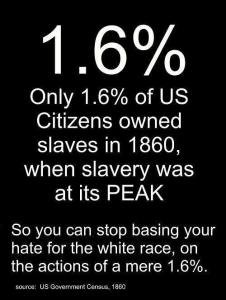The following is a tale of memes, bad history, poor logic, and misleading statistics. It is also a story about how information on Facebook can come unmoored from its original context and find itself applied in startlingly different directions. Above all, this narrative has to do with the way in which parts of the internet have helped perpetuate a culture of partisanship and intellectual sloppiness.
The meme above has circulated on Facebook for some time. One Thing after Another has traveled throughout the internet to find its origins—alas, without success. Like many other images, videos, messages, and memes on the internet, it has metastasized to the extent that it is impossible to locate where this tumor began.
What is clear, though, is that this kind of meme is a product of social media. Social media place a premium on concision, that is, the short, snappy expression of ideas. That is probably why wit, attempts at wit, or what passes for wit, seem to dominate posts on Facebook and, of course, Twitter; as we all know (or should know), brevity is the soul of wit. At the same time, the disposable nature of posts on platforms like Facebook (and particularly Snapchat) make for an environment that is not conducive to real discussion, mindfulness, or thought.
In their sober moments, most people probably understand these problems instinctually. And perhaps one can even realize how the nature of the social media world makes it particularly susceptible to hoaxes and other stupid gambits. Remember that one about how Mark Zuckerberg was going to give away $4.5 million to Facebook users who shared a “thank you” message? But why not latch onto a concrete example that involves history—such as the meme above that has aroused One Thing after Another’s ire?
The meme above is not particularly special. In fact, it is exemplary. It is a product of Facebook. It seems incisive, it sounds authoritative, and it appears relevant. It even cites a source in an official-sounding way. Only the dullest or most uninformed person could fail to catch the progressive message that makes an analogy between the 1.6% of 1860 and those who have been labeled the “1%” today. The rich, so the message seems to say, used us for their own purposes then in just the way that they use us now. Yet, like much else on Facebook, this meme is manipulative when it isn’t misleading. Its facts are wrong, its reasoning is faulty, and the analogy it makes is specious. And yet, when you look at the public’s reaction to this meme, you find that nobody is critical or educated enough to call it out.
We should begin by explaining what is wrong with this meme. Let us start with the 1.6% figure which was supposedly obtained from the Census of 1860. If one divides the number of slaveowners by the total free population of the United States, the figure is actually closer to 1.4%, but that’s not the main problem. Calculating the figure in such a way at all really minimizes the proportion of people who had a stake in slavery. First, determining the number of slaveowners relative to the number of “U.S. Citizens” is beside the point. Slaveowners did not “convince” all Americans “to fight a civil war.” Rather, they ostensibly convinced “the majority of southerners” to take up arms (more about why that statement is problematic later). For that reason, the number of slaveowners should be compared to the number of Southerners. But this issue brings us to a second distortion. If we want to figure out slavery’s true heft in the South, we really ought to establish how many families owned slaves. Doing so would show us how many white Southerners had an immediate interest in slavery. After all, the head of the household was not the only member of the family to value slavery. His wife, his children, and any other dependents had a stake in the institution. Indeed, as his children grew older, they too, in all likelihood, would become slaveowners themselves.
Figuring out what proportion of Southern families owned slaves is really quite simple. The University of Virginia has a Historical Census Browser that allows one to search, map, and calculate figures associated with various censuses (the calculator for the Census of 1860 is here). One Thing after Another has run the figures, but for convenience’s sake, we refer you to Andrew Hall at Dead Confederates: A Civil War Era Blog who has presented them in a tidy table. As you can see, about 31% of the families in the states that seceded owned slaves. The range runs from 49% of families in Mississippi to 20% of families in Arkansas. In some ways, these figures don’t even begin to capture slavery’s centrality to Southern social and economic life. Let us push to the side that slaves were responsible for producing the South’s main cash crops or that slaveowners often rented out slaves to those who did not have them. Let us just focus on the fact that almost a third of families in the Confederate states owned slaves. That figure gives one a much better sense of slavery’s gravity than “1.6%.”
Given these figures, a great number of these slaveowners could not have been “rich plantation owners.” In fact, according to the Census of 1850, half of all slaveowning families owned between one to four slaves. There were great plantation owners with over 100 slaves, but there were fewer than 8,000 families in this position in 1850 (compared to the almost 175,000 families that owned between one and four slaves). Clearly, slavery’s strength did not rest on the power of a few rich men. Rather, its strength was grounded in its distribution among a great many middling men.
This point is confirmed by Joseph Glatthaar’s General Lee’s Army: From Victory to Collapse. A very high proportion of men who volunteered to serve in the Confederacy’s Army of Northern Virginia were slaveowners, belonged to families of slaveowners, or had some connection to slavery. “Rich plantation owners” did not need to convince such men to fight; they were already willing to fight. And that fact completely undermines the point of our unfortunate meme.
Such a picture of slavery makes nonsense of the claim that slavery “reduced the value of their [Southerners’] own labor and pay.” Starting with Robert Fogel and Stanley Engerman’s Time on the Cross: The Economics of American Negro Slavery (1974), which was the first work to subject the economics of slavery to serious study, it has become increasingly clear to historians that slavery was very lucrative. That is why so many Southerners bought slaves. If Southerners did not invest in railroads or factories, that was because investment in slaves who could grow cotton was much more profitable. That fact accounts for the enormous amount of Southern capital tied up in slaves during the antebellum period. Confidence in the profitability of slavery was reflected by the fact that the price of slaves was skyrocketing up to the outbreak of the Civil War.
Some of you might read this post and think to yourself, “Congratulations One Thing after Another, are you proud of yourself for destroying a dumb meme?” No, One Thing after Another is not proud. The problem is that you can search the internet far and wide without locating a refutation of this meme. In fact, wherever you find this meme posted, you are sure to see that it has elicited a variety of comments that reveal the degree to which the ideas of historians and the beliefs of the public are separated by an enormous abyss. In other words, the meme seems to evoke historical lunacy and delusions among commenters.
Not only that, but the misinformation associated with this meme has spawned other inaccurate memes that repackage the “facts” in a very different interpretive framework.
If our initial meme was progressive in outlook, its offspring leans in a very different direction which is just as mistaken and just as dangerous (if not more so). What further memes will this meme generate? Where does it all end? How can academia counter the rapidly pullulating mass of memes that apparently pass for education on Facebook, Twitter, and Pinterest? By writing a blog post?

